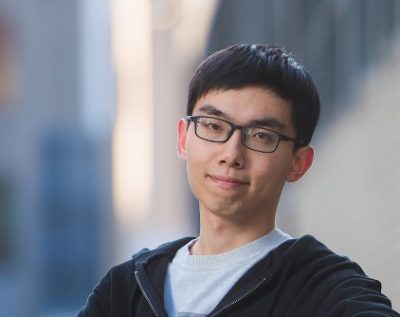
Changhao Li’s research focuses on exploiting the quantum properties of electronic and nuclear spins for novel applications ranging from quantum computation, quantum communication and quantum sensing. In particular, Changhao uses spin defects in nanodiamond to sense minuscule external perturbations arising from biological and chemical processes. A key breakthrough of his work has been to find efficient ways to transduce these signals into magnetic fields, that the quantum spin sensor can detect most efficiently. In recent work, Changhao has proposed to exploit the spin defect associated with the Nitrogen Vacancy (NV) center in diamond to detect the presence of the SARS-CoV‑2 virus with a sensitivity improvement over existing methods. Changhao is Ph.D. graduate student in the department of Nuclear Science and Engineering working in the Quantum Engineering Group supervised by Prof. Paola Cappellaro.

Grace Noel’s work focuses on a thermally drawn “acoustic fiber” containing a piezoelectric domain that can be incorporated into textiles to create fabric microphones. With the piezoelectric domain of the acoustic fiber sensing vibrations from the wearer, it can continuously and imperceptibly capture acoustic signals, functioning like a wearable stethoscope. In the thermal drawing process, multiple viscoelastic materials flow in a laminar regime, maintaining the cross-sectional geometry of the macroscopic preform. The acoustic fiber contains a piezoelectric composite domain, conductive polymer electrodes, and an elastomeric cladding, which co-flow at the elevated draw temperature and result in a multimaterial fiber device. Acoustic fibers detect heartbeat and breathing with high reliability, and arrays of fibers capture acoustic signals with high enough resolution to determine the direction of the sound source with 1‑degree accuracy. Given the success of the fiber in detecting adult heartbeat, Grace is now exploring using the acoustic fabric for fetal monitoring. Monitoring fetus activity can provide data for robust identification of at-risk pregnancies to provide proactive care and decrease fetal mortality. Given the acoustic fiber’s unprecedented piezoelectric coefficient and its unique form factor, she believes that this is only the beginning of using the fiber in biomedical applications. Grace is a Ph.D. student in the Department of Chemical Engineering, and she conducts research in the Fibers One Laboratory under the supervision of Prof. Yoel Fink.
